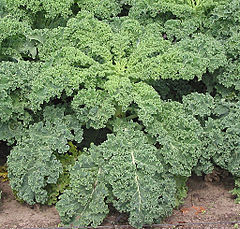
Nutritional Info According to Wikipedia:
Kale is very high in beta carotene, vitamin K, vitamin C, lutein, zeaxanthin, and reasonably rich in calcium. Kale, as with broccoli and otherbrassicas, contains sulforaphane (particularly when chopped or minced), a chemical with potent anti-cancer properties.[1] Boiling decreases the level of sulforaphane; however, steaming, microwaving, or stir frying do not result in significant loss.[2] Along with other brassica vegetables, kale is also a source of indole-3-carbinol, a chemical which boosts DNA repair in cells and appears to block the growth of cancer cells.[3][4] Kale is also a good source of carotenoids.[5]
It can be eaten raw, stir fried, steamed, baked, etc etc.
Some popular uses are adding it to soups, mashed potatoes, omelets, salads, and smoothies.
Stir fry it in with your beef. Dice it up into your salad or minestrone soup. Throw a handful into your fruit smoothie.
It is very versatile and IN SEASON-- which means you can find it on sale.
I recently bought some for the very first time and tried it out several different ways.
We really liked it in smoothies. It didn't effect the taste of the fruit too much, which means my kids drank it. You know it's a winner when the kids like it.
I also tried it in my omelet. I think you should steam them a bit first. I just threw it in fresh about half way through the cooking time and the kale was still very raw and crisp. It was a little disconcerting. Next time I will try steaming it.
Then I also followed a recipe from my friend Nicole S. to make Baked Kale Chips. I will post the directions.
So how do you eat your kale?
No comments:
Post a Comment